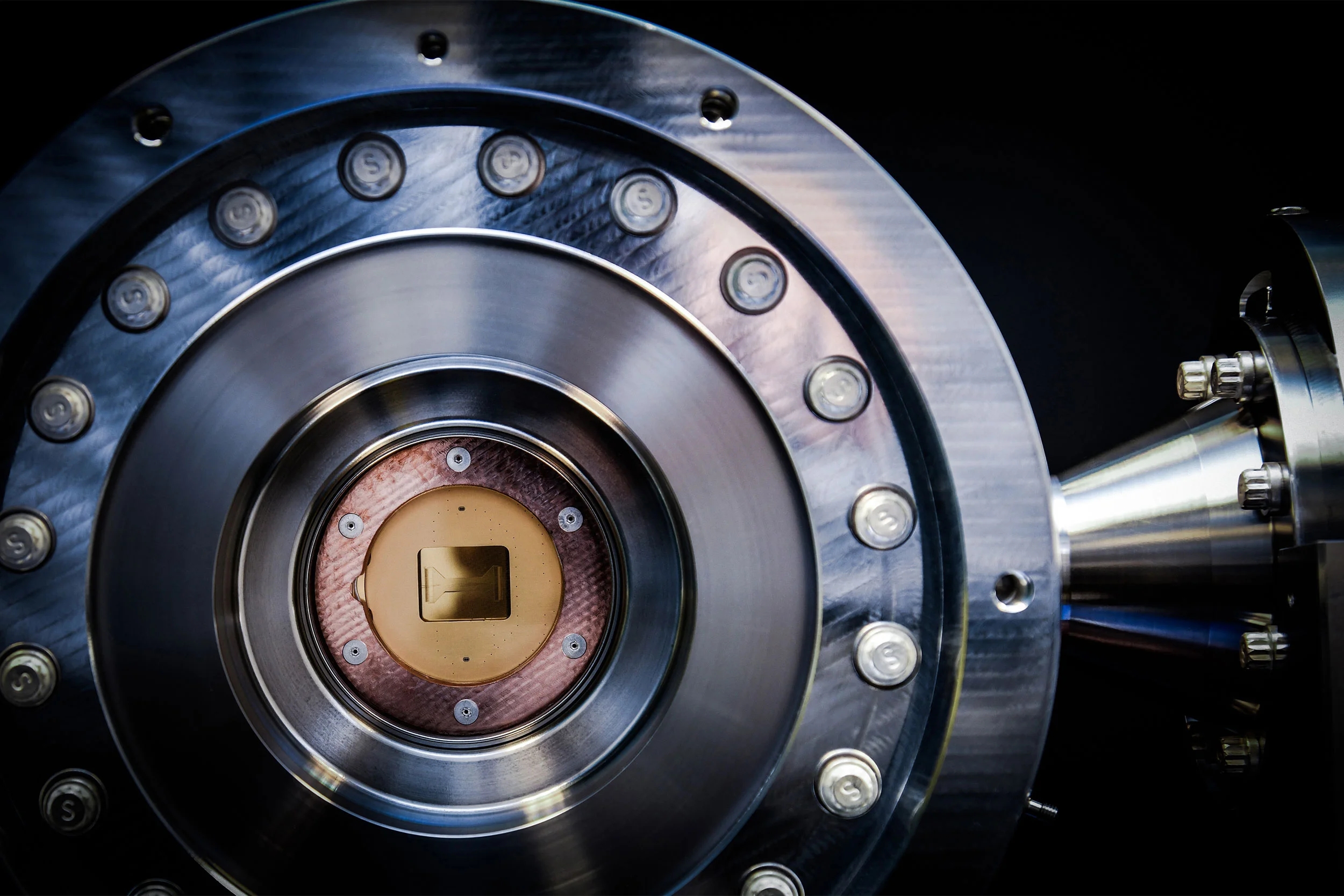物质的新阶段:物理学家在量子处理器中首次实现了非阿贝尔任意子的演示
诸平
Fig. 1 Inside the chamber of the Quantinuum H2 quantum processor. Courtesy of Quantinuum
Fig. 2 Ashvin Vishwanath, Henrik Dreyer (of Quantinuum), Nat Tantivasadakarn, and Ruben Verresen.
据物理学家组织网(phys.org)2024年2月21日转载美国《哈佛大学校报》(Harvard Gazette)2024年2月20日的报道,哈佛物理学家发现了物质的新形态。物质的新阶段:物理学家在量子处理器中首次实现了非阿贝尔任意子的演示(A new phase of matter: Physicists achieve first demonstration of non-Abelian anyons in a quantum processor)
我们的物理三维世界只由两种粒子组成:玻色子(bosons),包括光和著名的希格斯玻色子(Higgs boson);费米子(fermions)——质子(protons)、中子(neutrons)和电子(electrons)构成了所有的“物质”,包括在座的各位。
然而,像哈佛大学乔治·瓦斯默·莱弗里特物理学教授(Harvard's George Vasmer Leverett Professor of Physics)阿什温·维什瓦纳特(Ashvin Vishwanath)这样的理论物理学家,不喜欢把自己局限于我们的世界。例如,在二维环境中,各种新的粒子和物质状态都有可能出现。
阿什温·维什瓦纳特的团队使用一种名为量子处理器(quantum processor)的强大机器,首次制造了一种名为非阿贝尔拓扑序(non-Abelian topological order)的全新物质阶段。以前只在理论上得到认可,这个团队展示了一种被称为非阿贝尔任意子(non-Abelian anyons)的奇异粒子的合成和控制,它既不是玻色子也不是费米子,而是介于两者之间的东西。
他们与量子计算公司Quantinuum的研究人员合作的研究结果,于2024年2月14日已经在《自然》(Nature)杂志网站发表——Mohsin Iqbal, Nathanan Tantivasadakarn, Ruben Verresen, Sara L. Campbell, Joan M. Dreiling, Caroline Figgatt, John P. Gaebler, Jacob Johansen, Michael Mills, Steven A. Moses, Juan M. Pino, Anthony Ransford, Mary Rowe, Peter Siegfried, Russell P. Stutz, Michael Foss-Feig, Ashvin Vishwanath, Henrik Dreyer. Non-Abelian topological order and anyons on a trapped-ion processor. Nature, 2024, 626: 505–511. DOI: 10.1038/s41586-023-06934-4. Published: 14 February 2024. https://www.nature.com/articles/s41586-023-06934-4
参与此项研究的有来自德国量子计算公司Quantinuum(Quantinuum, Munich, Germany)的研究人员,也有来自美国Quantinuum(Quantinuum, Broomfield, CO, USA)的研究人员,还有来自美国加州理工学院(California Institute of Technology, Pasadena, CA, USA)以及美国哈佛大学(Harvard University, Cambridge, MA, USA)的研究人员。
非阿贝尔任意子(Non-Abelian anyons),被物理学家称为准粒子(quasi-particles),只有在二维平面上仅在数学上才有可能存在。限定词“准”("quasi")指的是这样一个事实,即它们不是确切的粒子,而是通过物质的特定阶段如海浪(ocean waves)产生的长期激发,它们具有特殊的承载记忆的能力。
除了创造物质的新阶段是令人兴奋的基础物理学之外,非阿贝尔任意子已被广泛认为是量子计算的潜在平台,这为研究成果注入了更大的意义。
非阿贝尔任意子本质上是稳定的,不像其他量子计算平台上脆弱且容易出错的量子比特(quantum bits)或量子位(qubits)。它们可以在彼此移动的时候“记住”自己的过去,就像魔术师把藏着球的杯子洗牌一样。这种特性也使它们具有拓扑性,或者能够弯曲和扭曲而不会失去其核心身份(core identity)。
由于所有这些原因,如果能够在更大的尺度上创造和控制非阿贝尔任意子,有朝一日可能会成为计算能力的理想量子比特单位,其计算能力远远超出当今的经典计算机。
Nathanan Tantivasadakarn说:“稳定量子计算的一个非常有前途的途径是使用这些奇异的物质状态作为有效的量子比特,并用它们进行量子计算。这样就在很大程度上缓解了噪音问题。”
研究人员运用了一些顽强的创造力来实现他们的奇异物质状态。为了最大限度地发挥Quantinuum最新H2处理器(Quantinuum's newest H2 processor)的能力,研究小组从一个由27个捕获离子组成的晶格开始。他们使用局部的、有针对性的测量来依次增加量子系统的复杂性,有效地得到了一个工程量子波函数,它具有他们所追求的粒子的确切性质和特征。
阿什温·维什瓦纳特说:“测量是量子力学中最神秘的方面,导致了著名的悖论,如薛定谔猫(Schrödinger’s cat)和无数的哲学辩论。在这里,我们使用测量作为工具来雕刻感兴趣的量子态。”
作为一名理论家,阿什温·维什瓦纳特珍惜在不同的物理学观点和应用之间跳跃的能力,而不是被束缚在一个平台或技术上。但在这项工作的背景下,他惊叹于不仅探索了一个理论,而且实际上证明了它,特别是在量子力学领域进入100周年之际(field of quantum mechanics enters its 100th year)。
阿什温·维什瓦纳特说:“至少对我来说,这一切都很神奇,我们可以做一些非常具体的事情。多年来,它确实连接了物理学的许多不同方面,从基础量子力学到这些新粒子的最新想法。”
本研究得到了美国加州理工学院沃尔特·伯克理论物理研究所(Walter Burke Institute for Theoretical Physics at Caltech)、哈佛量子计划科学与工程博士后奖学金(Harvard Quantum Initiative Postdoctoral Fellowship in Science and Engineering)以及西蒙斯基金会(Simons Collaboration on Ultra-Quantum Matter, which is a grant from the Simons Foundation 618615)的支持或资助。
上述介绍,仅供参考。欲了解更多信息,敬请注意浏览原文或者相关报道。
Non-Abelian topological order is a coveted state of matter with remarkable properties, including quasiparticles that can remember the sequence in which they are exchanged1,2,3,4. These anyonic excitations are promising building blocks of fault-tolerant quantum computers5,6. However, despite extensive efforts, non-Abelian topological order and its excitations have remained elusive, unlike the simpler quasiparticles or defects in Abelian topological order. Here we present the realization of non-Abelian topological order in the wavefunction prepared in a quantum processor and demonstrate control of its anyons. Using an adaptive circuit on Quantinuum’s H2 trapped-ion quantum processor, we create the ground-state wavefunction of D4 topological order on a kagome lattice of 27 qubits, with fidelity per site exceeding 98.4 per cent. By creating and moving anyons along Borromean rings in spacetime, anyon interferometry detects an intrinsically non-Abelian braiding process. Furthermore, tunnelling non-Abelions around a torus creates all 22 ground states, as well as an excited state with a single anyon—a peculiar feature of non-Abelian topological order. This work illustrates the counterintuitive nature of non-Abelions and enables their study in quantum devices.
转载本文请联系原作者获取授权,同时请注明本文来自诸平科学网博客。
链接地址:https://wap.sciencenet.cn/blog-212210-1423137.html?mobile=1
收藏



